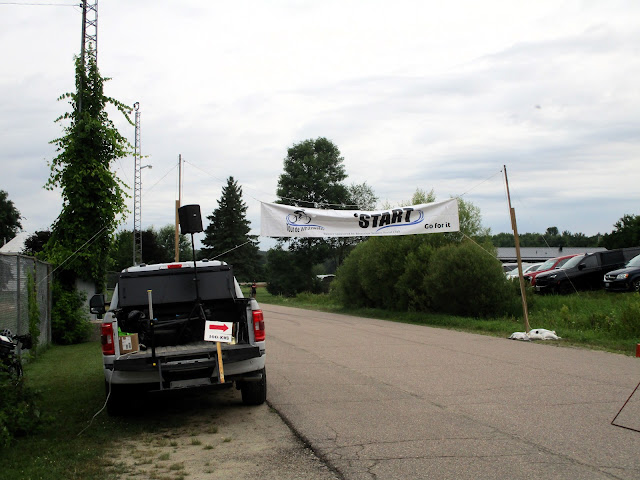Lake Placid, located in the New York State's Adirondack Mountains region, is one of only three places that have hosted the Winter Olympics twice, the others being Innsbruck and St. Moritz. Lake Placid held its events in 1932 and 1980 and remains a destination for winter sports enthusiasts, as well as for outdoor activities of all kinds throughout the year. It offers road cyclists some outstanding opportunities for riding and one of these is the Ironman Loop.
 |
| My route along the Lake Placid Ironman loop and Whiteface Mountain |
The first Ironman triathlon in Lake Placid took place in 1999 and for many years was the only Ironman venue in the United States besides the Ironman World Championships in Kona, Hawaii. The cycling course, which has varied slightly from year to year, is two circuits of a 90 km (56.5 mile) course. Each of these loops has an elevation gain of 640 m (2019 ft), with most of the gain coming in the second half.
Lake Placid, which is two hours' drive south of Montreal, is keen to market itself as a cycling region and many of the roads are marked to show bicycle traffic. Shoulders are paved and wideand generally in very good condition. All along the route, even when there is no Ironman on, there are “portable restrooms” marked with very visible signs. The scenery is beautiful although this route apparently ranks as one of the toughest Ironman courses. That said, the Men's Ironman World Championships, recently held in Nice, was much harder, featuring a bike course with double the elevation gain!
 |
| Main Street, Lake Placid |
 |
| The Pines Inn, my hotel |
On a beautiful early Fall day I rolled out of my hotel (possibly one of the very few budget alternatives in town and probably THE place to stay in Lake Placid circa 1912) and eased downhill and onto Main Street, which runs along the shore of Mirror Lake—for some reason the village of Lake Placid is not actually on nearby Lake Placid!--and takes you past an amazing number of restaurants, outdoor equipment stores, and realtors' offices. It takes you past the hockey arena where the 1980 “Miracle on Ice” match took place and the big high school, which has the Olympic speed skating oval in front of it. A little further and you are out of town and following Route 73 southeast in the direction of Keene
 |
| Olympic ice hockey venue |
 |
Although Route 73 had a fair amount of traffic on a Friday morning, the shoulders of the road make riding safe enough and for a good portion of the Ironman loop here the road goes downhill, making some sections very speedy indeed. Exhilarating, in fact.
Reaching the hamlet of Keene, you leave Route 73, turning left onto Hwy 9N, and enjoy a beautiful ride on a quiet road heading north alongside the Ausable River until reaching the hamlets of Upper Jay and Jay proper. Jay has a nice village green but is notable as having the only covered bridge in the Adirondacks. Originally built in 1857, it eventually fell into disrepair and was removed, while the current bridge, using original hand-hewn beams, was opened as a footbridge in 2007.
Another left turn takes you from Jay onto Route 86, which goes northwest and gradually climbs before the Ironman course takes another out-and-back detour along Haselton Road. Unlike most of the loop, this 22 km total section is shaded by tall trees and features lots of gentle climbs and descents as you reach the turnaround at the hamlet of Black Brook and come back. A really lovely section of road. Next stop: Wilmington.
 |
| View of Lake Placid |
Soon enough one is back in Lake Placid and unlike the Ironmen/women, I did not have to run a marathon after getting off the bike, thankfully. In all, I had covered 120 kms and climbing just under 2100 m. A beautiful day out that can be recommended for any cyclist—well, maybe with more modern gearing that my 34-26!
 |
| Mirror Lake, on the shores of which is found the town of Lake Placid, oddly |
As to the Ironman Lake Placid race taking place on July 21, 2024, this will be the 25th Anniversary Edition, with various special events. General registration sold out in August already for the 3,200 participants so you just have to do it on your own. The Ironman website provides a map and turn-by-turn instructions for the course here. The Veterans Memorial Highway information is here. And if you really want to race up Whiteface Mountain, you can check out the event information here.
I had planned to enjoy some craft beers at the nearby Lake Placid Brewing Company but my legs were so exhausted that the best I could do was stagger over to the nearby McDonalds, where I recall eating pretty much the entire menu. The next morning was not much better as I walked to a local diner and had the biggest meal, the Adirondack Breakfast, on the menu, which disappeared as soon as the waiter set it down. Apparently my ride the day before had used up something like 5,00 Kcal!
Feeling somewhat more myself and having packed the car, I drove over to a state historical park. This was the one-time home, and then only briefly, of famed abolitionist John Brown, who helped ignite the Civil War by leading a slave uprising to seize the arsenal at Harper's Ferry in Virginia in 1857. Executed for treason, he is buried with some of his followers at this farm in North Elba. It is a beautiful site and a peaceful setting considering its association with a pivotal and still-controversial figure in United States history. More information on the John Brown Farm may be found here.


















.jpg)
















.png)






